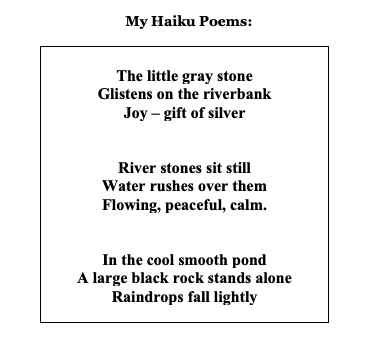It’s spring. The first graders are trying their hand at poetry. They scribble and draw and make images – some silly, some that will take your breath away. That is the beauty of first graders – the child-mind at work not afraid of making mistakes. They are intrepid and curious. I was so excited when their teacher invited me to “teach” haiku to them. I put teach in quotation marks because the first graders really taught me more about how they construct language than I really taught them. Their exuberance led the way. It energized me and made me see things anew. Isn’t that what poetry and haiku are all about?
At first, I asked the first graders what they knew about haiku. Lots of hands went up: it’s a little poem; it has three lines; it has a pattern with 5-7- syllables. They had been working all week learning and writing haiku. Next, we talked about how haiku is a Japanese form of poetry usually about nature. Then, I told them about Basho, a famous Japanese poet and shared some of his poems.

Then, I read Basho and the River Stones by Tim Myers. The story is about how the fox tricked Basho by giving him three pieces of gold for a cherry tree, but the gold turns into three stones. Basho out-foxes the fox, because he cares most about nature and poetry. It’s a great read aloud. It is a good story to use to introduce haiku.
After reading the story, we wrote some group haikus. First, we listed some natural things we could write a haiku about: seashells, stones, bunnies, flowers, sunshine, rain, etc. Then we made a list of how these things makes us feel: happy, sad, lonely, friendly, curious, excited. I read some of my haiku to them and we counted syllables to make sure I was keeping the haiku form.


Finally, the students got busy writing their own haikus. They were ready to go. No one hesitated. They took up their pencils and began to create. It is so gratifying to see how these are able to stretch words out, count syllables and think about meaning and emotion. The haiku form helps them keep focused and since it is short, it is easy for them to write two or three poems in one workshop session.


The best part for me is that I get to witness our students grow as readers and writers. By the time students get to 5th grade, they are putting it all together and coming up with a haiku in three stanzas. This writer lacked confidence when she was a young writer, and now you can see in her composition how far she has come. Haiku is a celebration not only of nature but of growth and possibility.


The excitement is evident through your descriptions, the photos, and those lovely haikus you shared. What a delightful time to be with the first graders!
LikeLike
I love this so much! Your examples and what you are doing in your class is great. So many teachers are upset that older students can’t write and I always ask about instruction. It starts in K and 1!!!! Kudos!! Your students are adorable.
LikeLike
Their work is so beautiful! I love the confidence with which they write. This is an inspiring story for the end of the year!
LikeLike
I think we need to get in touch with our inner first grader more often when stuck with writing. I admire their writerly spirit and playfulness.
LikeLike
Wow!
LikeLike